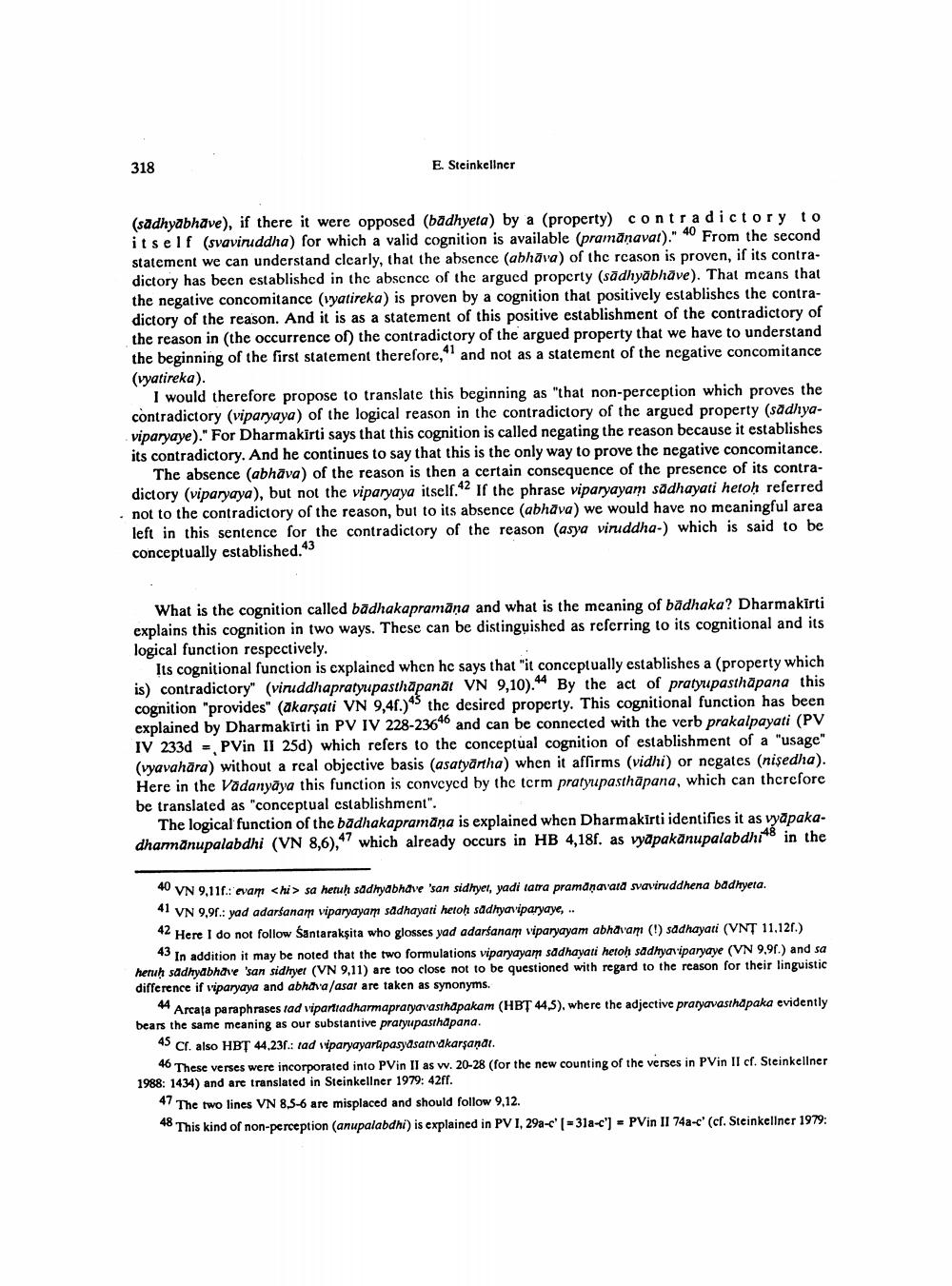Book Title: Logic Of Svabhavahetu In Dhharmakirtis Vadanyaya Author(s): Ernat Steinkellner Publisher: Ernat Steinkellner View full book textPage 8
________________ 318 E. Steinkellner (sadhyabhave), if there it were opposed (badhyeta) by a (property) contradictory to itself (svaviruddha) for which a valid cognition is available (pramänavat)." 40 From the second statement we can understand clearly, that the absence (abhāva) of the reason is proven, if its contradictory has been established in the absence of the argued property (sādhyabhāve). That means that the negative concomitance (vyatireka) is proven by a cognition that positively establishes the contradictory of the reason. And it is as a statement of this positive establishment of the contradictory of the reason in the occurrence of the contradictory of the argued property that we have to understand the beginning of the first statement therefore, and not as a statement of the negative concomitance (vyatireka). I would therefore propose to translate this beginning as "that non-perception which proves the contradictory (viparyaya) of the logical reason in the contradictory of the argued property (sadhyaviparyaye)." For Dharmakirti says that this cognition is called negating the reason because it establishes its contradictory. And he continues to say that this is the only way to prove the negative concomitance. The absence (abhava) of the reason is then a certain consequence of the presence of its contradictory (viparyaya), but not the viparyaya itself." If the phrase viparyayam sadhayati hetoh referred not to the contradictory of the reason, but to its absence (abhāva) we would have no meaningful area left in this sentence for the contradictory of the reason (asya viruddha-) which is said to be conceptually established." What is the cognition called badhakapramāna and what is the meaning of badhaka? Dharmakirti explains this cognition in two ways. These can be distinguished as referring to its cognitional and its logical function respectively. Its cognitional function is explained when he says that "it conceptually establishes a (property which is) contradictory" (vinuddhapratyupasthāpanāt VN 9,10).44 By the act of pratyupasthāpana this cognition "provides" (akaryati VN 9,4.) the desired property. This cognitional function has been explained by Dharmakirti in PV IV 228-23646 and can be connected with the verb prakalpayati (PV IV 233d - PVin II 25d) which refers to the conceptual cognition of establishment of a "usage" (vyavahāra) without a real objective basis (asatyārtha) when it affirms (vidhi) or negates (nisedha). Here in the Vadanyāya this function is conveyed by the term pratyupasthāpana, which can therefore be translated as "conceptual establishment". The logical function of the badhakapramāņa is explained when Dharmakirti identifies it as vyāpakadharmānupalabdhi (VN 8,6),47 which already occurs in HB 4,18f. as vyāpakānupalabdh148 in the 40 VN 9,11f: evam <hi > sa heruh sadhyabhave 'san sidhyet, yadi tatra pramanavara svaviruddhena badhyeta. 41 VN 9,91.: yad adarsanam viparyayam sadhayari hetoh sadhiyaviparyaye, .. 42 Here I do not follow Śantarakṣita who glosses yad adarśanam viparyayam abhavam (!) sadhayati (VNT 11.12.) * In addition it may be noted that the two formulations viparyayam sadhayati hetoh sadhyaviparyaye (VN 9.91.) and sa heruh sadhyabhave 'san sidhyer (VN 9,11) are too close not to be questioned with regard to the reason for their linguistic difference if viparyaya and abhava/asat are taken as synonyms. 44 Arcata paraphrases tad vipartiadharmapraryavasthapakam (HBT 44,5), where the adjective pratyavasthapaka evidently bears the same meaning as our substantive pratyupasthapana. 45 Cf. also HBT 44,23f.: tad viparyayarapasydsarvakarsandt. 40 These verses were incorporated into PVin II as w. 20-28 (for the new counting of the verses in PVin II cf. Steinkellner 1988: 1434) and are translated in Steinkellner 1979: 42ff. 47 The two lines VN 8.5-6 are misplaced and should follow 9,12. 48 This kind of non-perception (anupalabdhi) is explained in PV I, 29a-c' (=31a-c") = PVin II 74a-c' (cf. Steinkellner 1979:Page Navigation
1 ... 6 7 8 9 10 11 12 13
